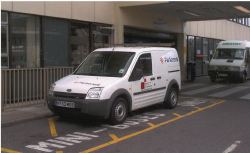Know the rules — new trends in electrical testing and inspection

Helping the Oxford Radcliffe Hospital NHS Trust comply with the Electricity at Work Regulations 1989 is the commissioning of the specialist electrical-testing and inspection division of Parkersell to test, trace, report and action repairs of fixed electrical installation in its hospitals.
The work includes all equipment up to 415 V. The service provided by Parkersell includes producing periodic inspection reports on the fixed electrical installations, which are tested to ensure they continue to function safely and correctly.
Ensuring that electrical installations in commercial buildings comply with regulations requires a planned programme of inspection and testing. ANDRE DUFAYE outlines what is involved.By law, in accordance with the Electricity at Work Regulations 1989, precautions must be taken against the risk of death or personal injury from electricity at work activities. Neglecting faulty electrical systems could result in injuries to employees, lost income and fines for organisations found to be in breach of statutory responsibilities. In some instances it may even invalidate insurance claims, whilst the move towards custodial sentences for directors of companies found to be in breach of their obligations is gaining pace.
Obligations It is therefore important to keep a record of the condition of electrical systems and help to fulfil obligations to the Electricity at Work Regulations 1989 and the Health & Safety at Work Act 1974. Other guidelines that need to be considered include the IEE’s Wiring Regulations 16th Edition. Indeed, these new guidelines are driving more organisations to undertake fixed-wire testing. Until recently fixed-wire testing has generally taken place on a 5-year cycle, covering testing up to the point of isolation of the equipment. However, sub-clause 3.5 Routine Checks in guidance note 3 published by the IEE states that electrical installations should not be left without attention for periods of five years between formal inspections. Because of this, and the fact that most establishments do not have staff who could be classified as competent in electricity, there is now a move towards full visual inspections on an annual basis, coupled to a 20% physical test of the wiring every year — building up to a full set of test results over the 5-year period. The annual inspection and 20% test can be wrapped up at the same time with other electrical services such as portable-appliance testing, thereby helping to reduce overall costs. All electrical installations should be tested and inspected periodically, as well as on their original completion and when alterations are carried out. Other areas, which need to be tested include portable and fixed appliances, emergency lights and fire alarms. The inspection and testing of a hazardous area is another highly topical area, relating to the testing of an electrical installation and associated equipment within the hazardous areas such as petrol filling stations and paint stores. Examples include a car wash, jet wash, air dispensers and signs. Inspections are carried out to verify that they are of the correct type for the installations and that they satisfy the requirements for the local environment. With regard to the revised regulations for emergency lighting and fire alarms, certain daily, monthly, 6-monthly and annual inspection and tests are required. The daily and monthly checks are usually undertaken by a responsible member of staff, whilst the more onerous tests are carried out by experienced external specialistcontractors.
New techniques Newly developed test and inspection techniques include thermal imaging which provides a preventative-maintenance tool to help highlight developing faults before they become a costly problem. It pinpoints potential faults and allows repairs to be made at a pre-planned convenient shut down period. An infrared survey of electrical equipment will identify problems caused by current/resistance relationships. Typically, a hot spot will usually be generated in an electrical circuit and when this occurs, a thermogram will highlight it. Today, there are highly skilled, qualified and competent electricians who can inspect electrical systems to highlight potential danger areas in line with the above requirements and recommend courses of action, as appropriate. Only an NICEIC (National Inspection Council for Electrical Installation Contracting) accredited company can provide NICEIC certification. To hold that accreditation, its engineers must hold extensive qualifications which include City & Guilds 2361, 2381 and 2391 qualifications. It is always worth checking.
Certificates When it comes to storing test results and the presentation of test certificates, customers are putting more demands on the testing company. This has resulted in the development of many general software packages that contractors use. The more sophisticated companies have also developed their own dedicated packages, which allow certificates to be printed straight from the engineer’s laptop. Companies such as Parkersell are well advanced in this field, and the retrieval of test results by computer and the ability to download them to the customer’s own computer systems is well received by customers from all sectors — retail, commercial, NHS Trusts, industry and local authorities to name a few.
André Dufaye is with the electrical and testing division of Parkersell Lighting & Electrical Services, The Connect Centre, Kingston Crescent, Portsmouth, Hants PO2 8QL.
Related links:









